The railway town of Quorn is nestled in a valley of the Flinders Ranges in the north of South Australia. The town is located just 39 km from Port Augusta and 3.5 hours from Adelaide, and the menacing Devil's Peak is 11km to the west.
Quorn,
is named after Quorndon in Leicestershire, the United Kingdom, looks like a film-set with its picturesque setting and heritage buildings.
The town has been the location for many films, such as Sunday Too Far Away, Gallipoli (1981), The Water Diviner (2014).
The Nukunu People
The land of the Nukunu people, according to Norman Tindale, was an area of 5,700 km2, located on the east side of the Spencer Gulf and the Southern Flinders Ranges.
The name Nukunu, however, was a word used by other tribes, such as the Kaurna, Peramangk, and the Ngarrindjeri, to describe the Aboriginal people of the Flinders Rangers as "assassins", due to their religious practices.
The Nukunnu people were regarded by other tribes with great hostility due to their actions of sneaking into a camp while people were asleep and using a bone or other implement to collect kidney fat. The wound of the person would close, but the person still died within three days. (Paul
Simpson, 2011).
Nukunu country also has sites related to the longest known continuous Aboriginal song-lines, the Urumbula. This
songline is based on a giant tree which once existed in today's Port Augusta. This tree represented the milky way.
Interestingly, the Nukunu practised circumcision and another form of genital modification or mutilation called subincision. Read about it and view pictures on
Wikipedia.
The ancient Aboriginal site of Yourambulla Caves Historic Reserve is located 57 km north of Quorn. This site is one of seven Aboriginal sites in the Flinders Ranges region where cave art can be viewed.
The caves can be accessed by
following a walking trail which leads to a tall iron ladder. Climb the ladder to reach the caves and the paintings, which are old and precious and to be treated with respect and care.
The Mimbara horde lived near Quorn, in the northern bushlands until 1905, the last "wild" Aboriginal group in southern South Australia.
 |
| South Australian Aborigines - very early 1900s. PD |
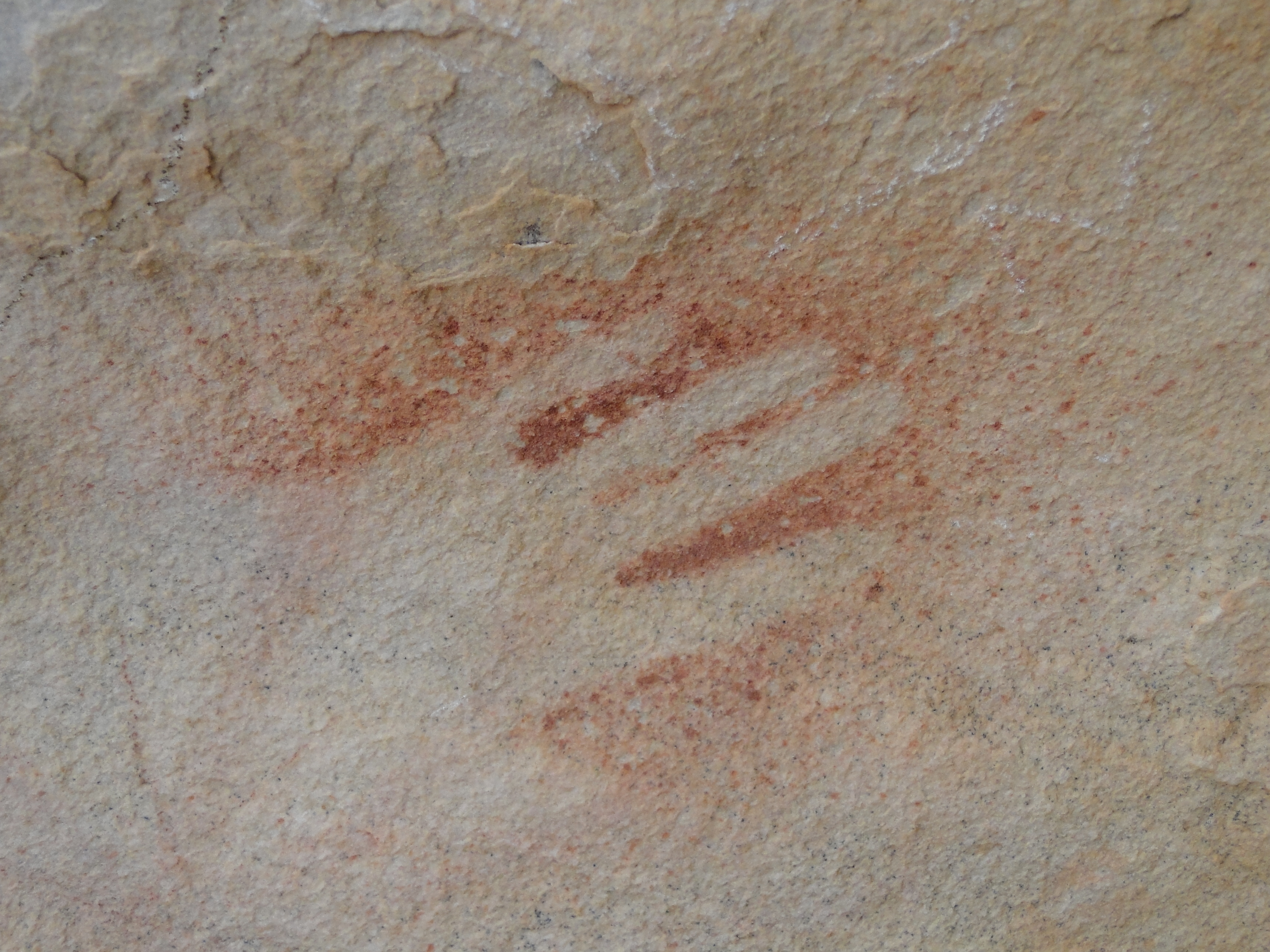 |
| An ancient Indigenous Australian art work, a hand outlined by the artist spraying red ochre from the mouth. In the caves at Yourambulla, South Australia. This is by the Adnyamathanha people, and maybe thousands of years old. Peterdownunder |
1850s
The first European squatters and pastoralists arrived in the Quorn area in the 1850s.
1870s
Quorn
began as a railway town after Godfrey Walsh surveyed the area in 1878 as a rail junction of what would become the Great Northern Railway.
Farms had already existed in the Quorn area for some years before the coming of the railway. For example, Kanyaka Station, 40 km north-north-east of Quorn, was established as a cattle station in February 1852 by Hugh Proby. At one time, Quorn was part of the Kanyaka Sheep Station, with the
head station at Mount Arden.
 |
| Ruins of Kanyaka Station, 40km from Quorn, South Australia.Talexbikes |
 |
| Quorn Railway Station with part of town in background. Approximately 1876. SLSA |
Cowan's Mill at Quorn opened on December 14 1878, driven by a Tangye compound steam engine. At this time several hotels and stone houses already existed at Quorn. After the Mill closed, the building was used as a Butter Factory. Cowan’s Flour Mill (est 1878) and Dunn’s Flour Mill (1879) on Railway Terrace, both had private sidings to transport their grain and flour.
 |
| Adelaide Observer (SA : 1843 - 1904), Saturday 28 December 1878 |
Austral Hotel built in 1878
was originally called the Pinkerton Hotel, after William Pinkerton, who had camped in the Quorn area whilst droving sheep from the West Coast in 1853. It was one the first hotels built in Quorn when this town was surveyed in 1878.
Transcontinental Hotel
was built in 1878. And in the same year, The first National Bank opened and the Post Office.
 |
| South Australian Advertiser (Adelaide, SA : 1858 - 1889), Thursday 12 December 1878 |
In 1878 construction of the Great Northern railway from Port Augusta through Pichi Richi Pass in the Flinders Ranges
towards Quorn.
 |
| Adelaide Observer (SA : 1843 - 1904), Saturday 31 August 1878 |
Mr Dunn built a second three storied flour mill in 1879. This mill became a motel in the 1960s.
The Court House was built in 1879.
The Quorn Primary School opened in 1879 as a provisional school with an average daily attendance of 36 children.
The establishment of various bank branches at Quorn from the late 1870s to 1890s shows the development of Quorn as a rail and commercial centre. The solidity and ornate charter of the buildings also demonstrate
the optimism and growing economic importance of Quorn, at least for a period.
In 1879 the railway line from Port Augusta to Quorn opened and then extended in 1882, to Government Gums (Farina), Marree in 1884, Oodnadatta in 1890 and Alice Springs in 1929.
The
first land allotments were sold at auction on May 30, 1878. The highest price was paid for allotment 65 (1/4acre), on which the Hotel Austral now stands. It was purchased by William Armstrong.
 |
| Port Augusta Dispatch (SA : 1877 - 1880), Friday 24 October 1879 |
1880s
 |
Railway Terrace, Quorn with J. Cowan's Quorn Flour Mills and the Grand Junction Hotel at left, circa 1880. State Library of SA
|
The Methodist Church was constructed in 1880, and the Anglican in the same year (replaced in 1897).
Criterion Hotel and the Institute were built in 1881.
Catholic Church constructed in 1883. And the the Salvation Army Hall in the following year.
In 1883 the school had total enrolments of 226 with
the daily average attendance of 91.
 |
| A photo of Quorn, SA, in the 1870-80s, Chronicle (Adelaide, SA : 1895 - 1954) |
 |
| Evening Journal (Adelaide, SA : 1869 - 1912), Saturday 29 May 1886 |
Matthews Emporium was built in 1886.
 |
The English Scottish and Australian bank closed in 1892 and the Bank of Adelaide rented the building. Before1881, the bank had been operating in a weatherboard building on Railway Tcrrace. Written on reverse: Father, Richard Henry Blanks on left, in Quorn. Married Annie Fergusson at Quorn. First child me Marjorie, than David. Left Quron for Jamestown (where Mavis was born when I was six), when I was 3 years and David 1 yr. Four years later went to Broken Hill for 7 years, then to the Esplanade Semaphore. Hurrah! After dusty old B.H. it was heavenly. Building located on the corner of Railway Terrace and Fourth Street in Quorn
|
1890s
The Lutheran Church was built in 1890.
On February 7, 1891, the foundation stone of the Quorn Town Hall was laid. This was just over twelve years from the erection of the first building in the town. Since that time, farming developed, especially sheep. The population
of the town was also increasing, and the Transcontinental Railway was being steadily built across Australia.
 |
View of the Quorn Cash, Boot & Shoe Emporium premises, Quorn, SA, with a number of horse-drawn buggies lined up out the front. Circa 1890
|
 |
Express and Telegraph (Adelaide, SA : 1867 - 1922), Thursday 22 December 1892
|
 |
Transcontinental Hotel, Quorn SA, circa 1889. The proprietor at this time was WA Jones. The hotel in Railway Terrace existed since 1878. Sate Library of SA
|
 |
| Quorn Mercury (SA : 1895 - 1954), Friday 16 July 1897 |
 |
| Grand Junction Hotel, 25 Railway Terrace, Quorn, SA, licenced by J.A. Watt. The first licence was from 1888 to 1890 was John Lord, who was also mayor of the town from 1888-1890 (photo 1907). Sate Library of SA |
1900s
 |
| Quorn Footballers. From left to right.—First row—R. Tonkin, A. Perry, N. Huddy, R.Stuart, ). Saville, G. Harrison. Second row—D. Croker, P. Snadden, S. Lyons. W. Saville (Captain), M. O Brien, A. White (Umpire)Third row—B. Brain, T. Williams, J. Whiteforde, F. Herde.Port Augusta and Stirling Illustrated News (SA : 1901), Thursday 15 August 1901 |
 |
Railway Terrace, Quorn, SA. Quorn is a township and railhead in the Flinders Ranges. The railway line was opened in 1879 and later four hotels were established on Railway Terrace. Many other important buildings were situated along Railway Terrace namely, The Flour Mill, ES&A Bank, National Bank, Town Hall, Post Office and Police Station, circa 1901. State Library of SA
|
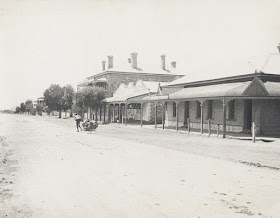 |
Austral Hotel, Quorn, SA, an early view taken before the addition of a second story, 1905. State Library of SA
|
 |
| Quorn Mercury (SA : 1895 - 1954), Tuesday 3 January 1905 |
 |
| Quorn Mercury (SA : 1895 - 1954), Tuesday 7 November 1905 |
 |
| Gunter's Restaurant, Quorn, South Australia - - circa 1906 - advertising postcard, Kaye. William and Annie Gunter are listed as operating a butcher shop at Quorn from 1885-1901 and a boarding house at Quorn in 1908 |
The Town Hall was constructed in 1907.
 |
Adam's Cash Store in Quorn, South Australia, 1907. The building dating from 1878 was originally as saddlery operated by Edward Manton
|

Quorn Railway Station, SA, circa 1910. State Library of SA
 |
| The Commonwealth Railways steam rail car, known as the 'Coffee Pot', which ran between Quorn and Hawker, South Australia. Circa 1910 (Roger Nott Collection - Nat Library of Aust), Kaye |
 |
| RESERVOIR & BRUSE'S CRITERIAN HOTEL, QUORN, SOUTH AUSTRALIA - circa 1912, Kaye |
The railway station with its Dutch gables was built in 1916.
In 1914 the school building on Railway Terrace was officially declared a High School.
 |
Premises of H. Matthews, general merchants, Quorn, SA. Circa 1915. State Library of SA
|
 |
A sheep sale in progress at Quorn, SA. Circa 1915. State Library of SA
|
 |
Criterion Hotel, Quorn, SA. W. Bruse was the publican from 1903 to 1920. Criterion Hotel, 20 Railway Terrace. William Bruse held the licence to the Transcontinental Hotel between 1900 to 1902 and took over at the Criterion in 1903 and added a first floor billiard room known as Bruse's Hall. State Libray of SA
|
WWI
During World War II, Quorn was a was a major troop
stop over, and hundreds of workers were employed by the railways. The Country Women’s Association provided more than 1 million meals to servicemen.
 |
ON ACTIVE. SERVICE. MILITARY CROSS WINNER. Lieutenant R. E. Nowell Twopeny, who
has been awarded the Military Cross, Lieutenant R. E. N. Twopeny, M.M. a son of Mi. and Mrs. E. N. Twopenny, of Quorn. Advertiser (Adelaide, SA : 1889 - 1931), Wednesday 9 May 1917 |
"LATE PTE. G. WELLS.
Pte. George Wells, of Quorn, who has been
killed at the front bad bean campaigning about
10 months. He was 23 years of age, was born
at Quorn, and educated at the Wilmington Public
School. He was a fine type of manhood end
worker on farms in the Quorn district, and lat
terly at Kangaroo Island, prior to his enlistment.
Pte. Wells was universally liked and respected.
His mother died while he was in France."Observer (Adelaide, SA : 1905 - 1931), Saturday 9 February 1918
Quorn was the junction for the western line to Perth and the northern line to Oodnadatta and Alice Springs. The narrow-gauge line from Port Augusta reached Quorn in 1879. However, Quorn’s major period of importance as a railway centre was between 1917 and 1937.
 |
| FESTIVITIES IN QUORN, SOUTH AUSTRALIA - CIRCA 1917, Kaye |
"When the train arrived at Quorn late in the afternoon, it was met by a porter with a hand cart from each hotel. These porters conducted the passengers to the hotel of their choice, carrying the baggage on the carts. The charge for dinner, bed and breakfast was 1/6"
1920sQuorn Power House, 1923, supplied electricity with generators before Quorn was connected to the state-wide grid.
"Quorn is a beautifully situated town, and its asphalt footpaths and electrically lighted streets......" 1924 (
1.)
The Australian Aborigines Mission established Colebrook initially at Oodnadatta in1926,
moving to Quorn in the following year.
 |
The Mission Home at Quorn, located on the southwest corner of First Street and Fifth Street. Circa 1920. Children like Nellie Lester, who were deemed to be "half-cast"were removed from their "perceived harmful surroundings" and sent to mission homes. The mission at Quorn became known as he Colebrook Children's Home. The children attended the local state school
|
 |
| Register (Adelaide, SA : 1901 - 1929), Tuesday 9 November 1926 |
 |
| Missionaries, Council Members and Children of Colebrook Home, Quorn, S.A. - circa 1927, Kaye |
 |
| On Wednesday last week a fine procession of decorated motor cars and other vehicles was held in connection with the Back to Quorn carnival. 1. The procession passing down Railway-terrace Chronicle (Adelaide, SA : 1895 - 1954), Saturday 6 October 1928 |
 |
| Register (Adelaide, SA : 1901 - 1929), Tuesday 25 September 1928 |
Quorn Town Hall, SA (top) and the high school at Quorn, SA, (bottom) Register (Adelaide, SA : 1901 - 1929), Tuesday 25 September 1928
 |
| I. The railway bridge in the Pichi Richi Pass, with the Devil's Peak in the background. 2. Sixth-street, Cuorn, from the south, with the Soldiers' Memorial in the reserve at the end of the street. Chronicle (Adelaide, SA : 1895 - 1954), Saturday 11 August 1928 |
 |
| I. Pichi Richi Pass, near Quorn, with Devil's Peek in the background. 2. The Town Hall, Quorn. Chronicle (Adelaide, SA : 1895 - 1954), Saturday 4 August 1928 |
1930s
 |
| Register News-Pictorial (Adelaide, SA : 1929 - 1931), Thursday 17 April 1930 |
 |
| Town Hall and hotels in Railway Terrace, Quorn, S.A. - circa 1930, Kaye |
 |
| Quorn Mercury (SA : 1895 - 1954), Friday 12 October 1934 |
 |
| NEW BOWLING CLUB HOUSE. Scene on the Quorn Bowling G reen the other day when the new club house was formally opened. The first bowl was sent down by Mrs. Rhodes. Chronicle (Adelaide, SA : 1895 - 1954), Thursday 12 November 1936 |
 |
| CHILDREN'S PLAYGROUND AT QUORN. Mr. L. B. Adams opening the children's playground at Quorn. It has been established by public subscription as a memorial to the late Mr. Robert Thompson, who was for 25 years mayor of the town, and a liberal benefactor in any cause devoted to children Chronicle (Adelaide, SA : 1895 - 1954), Thursday 4 November 1937 |
 |
CHILDREN FROM THE QUORN aborigines' home are spending some of the most thrilling moments of their holiday in the Semaphore fire station. Big boots, axes, and brass helmets are on attraction. Advertiser (Adelaide, SA : 1931 - 1954), Wednesday 6 January 1937 |
 |
| Mail (Adelaide, SA : 1912 - 1954), Saturday 11 June 1938 |
 |
THE CHILD ON THE LEFT IS DAVID,'four-year-old son of Jimmy James, the blacktracker, who so nobly assisted the police in their investigations into the Monash murder last week. He is being cared for by a young girl, who has absorbed our education with amazing facility. She obtained her qualifying certificate at the rormol age and then passed the Salvation Army cadet examination, being near the top of the list for the State. In spite of' starting her schooling late, she was soon top of her class at a State school, and retained the position while there. She was born in the area which is now being served by the Ernabella Mission, and received her upbringing at the Colebrook Home,.:Quorn. News (Adelaide, SA : 1923 - 1954), Monday 13 June 193 |
 |
A number of former residents of Quorn held a reunion picnic meeting at Elder Park last week Chronicle. (Adelaide, SA : 1895 - 1954), Thursday 14 April 1938 |
1940s and WII
Then during World War II, hundreds of people were employed by the railway, as Quorn was a stop-over point for troops and evacuees, especially, after the japan bombing of Darwin in 1941. The Quorn Country Women’s Association (CWA) provided
many home-cooked meals to the troops and evacuees.
 |
| Men standing in front of train., Quorn SA, circa 1941. This work (Quorn), identified by NT Library |
| Name: | Arthur Alexander Anzac Harding |
|---|
| Birth Date: | 25 Jul 1916 |
|---|
| Birth Place: | Quorn, South Australia |
|---|
| Year Range: | 1939-1948 |
|---|
| Enlistment Place: | Adelaide, South Australia |
|---|
| Service Number: | SX8454 |
|---|
| Father: | Joseph Harding |
|---|
| Series Description: | B883: Army, 2nd Al F |
|---|
National Archives of Australia; Canberra, Australia; Second Australian Imperial Force Personnel Dossiers, 1939-1947; Series: B883 |
| Aircraftwoman Jean Florence Chapman. of Quorn, SA. News (Adelaide, SA : 1923 - 1954), Friday 30 October 1942 |
 |
| Mail (Adelaide, SA : 1912 - 1954), Saturday 27 October 1945 |
Nellie Lester was the first Aboriginal person to attend High School at Quorn, South Australia and the first Aboriginal, triple certified, nursing sister and first Matron of Aboriginal descent.
 |
Mail (Adelaide, SA : 1912 - 1954), Saturday 3 May 1947
|
 |
| Chips Rafferty dances with debutante Miss Rosemary Crowe at the M.B.H.A. centre annual debutante ball at Quorn on frriday night. Barrier Miner (Broken Hill, NSW : 1888 - 1954), Tuesday 7 June 1949 |
 |
| ENGLISH COMEDIAN, Tommy Trinder, star of "Bitter Springs" now being filmed at Warren Gorge, near Quorn, has a smoke and a chat with aboriginal Clyde Combo, who is also in the cast. Combo also had parts in "The Overlanders" and "Bush Christmas." News (Adelaide, SA : 1923 - 1954), Tuesday 7 June 1949 |
 |
QUORN CHILDREN went out of their way to brighten the stay at Quorn of aboriginal children who will be extras in the Ealing film 'Bitter Springs.' Two were Fred McLean (left) and Richard Garrett who taught Robert, from Ooldea Mission, to ride a bike. Mail (Adelaide, SA : 1912 - 1954), Saturday 21 May 1949 |
 |
| News (Adelaide, SA : 1923 - 1954), Saturday 25 June 1949 |
In 1956 a new standard gauge railway to Marree and the Leigh Creek coalfields bypassed Quorn. The remaining narrow gauge line between Stirling North, Quorn and Hawker was abandoned in 1972.
 |
Because "Bitter Springs," Ealing's Australian film, was made at Quorn, South Australia, the studio chose Adelaide for the world premiere last Friday. Australian Women's Weekly (1933 - 1982), Saturday 1 July 1950 |
 |
Fos Williams (West) is one of four Quorn brothers to play league football in Adelaide. He
joined West in 1946 *, News (Adelaide, SA : 1923 - 1954), Saturday 8 July 1950 |
In 1956 a new standard gauge railway to Marree and the Leigh Creek coal fields was built and this led to Quorn's decline.
1960s
 |
| Quorn, SA, main street August Australian History Camp 1967, denisbin |
1970s
The Pichi Richi Railway Preservation Society (PRRPS) operating museum formed in 1973, staffed by its volunteer members. It operates heritage steam and diesel trains on the restored 39 kilometre section of track between Quorn and Port Augusta.
The name Pichi Richi is believed to be derived from
pituri which was
produced around the Quorn area, a mixture of leaves and ash chewed as a stimulant by Australian Aboriginal people.
1980s
Over the weekend of 17 and 18 October 1981, the Steamtown Peterborough Railway Preservation Society Inc. ran a train to Quorn.
 |
| Quorn Station 22,10,1986, making of The Shiralee in 1987 in Quorn station, Alco961 |
2000s
The Afghan Express, introduced in 2000, allows passengers to travel from Quorn to Stirling North by rail.
Some of The Old Timers of QuornOne of t
he oldest settlers in the Quorn district was Joseph Brewster and his wife, Sarah Ann (nee Burdett) of Peak Valley, at the foot of the Devil's Peak. Joseph was born in Nottinghamshire, England and arrived in Australia at the age of 20 in 1869, and Sarah was born at Dry Creek, South Australia.
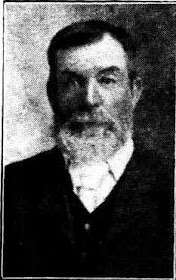 |
| Joseph Brewster (1848-1939) Quorn Mercury (SA : 1895 - 1954), Friday 20 September 1929. In 1923 "Hartley Lodge" private hospital was started in the corner building by Mrs A Brewster. |
 |
THE WRIGHT FAMILY.
Front row— Mr. W. J. Wright, aged 72; W. M. Wright, fifi: H. V. Wright, 64. Back row— J. A.
Wright, 62; G. H. Wright, 60. A sister (Mrs. J. M. Kelly, aged 60) went to Quorn in 1877,and has resided there ever since.Chronicle (Adelaide, SA : 1895 - 1954), Saturday 27 October 1928 |
Around Quorn
 |
| Savings Bank of SA building, Quorn, SA. This building was a saddlery in the early 1890s. It was later converted into a shop and private residence by Mr Rock. The Bank of SA purchased the building in 1909 |
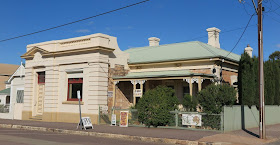 |
The land on which the National Australia Bank stands, in Quorn SA, was granted to John C. Philips by the Governor, Sir William F.D. Jervois, in 1878. The building was completed in 1880
|
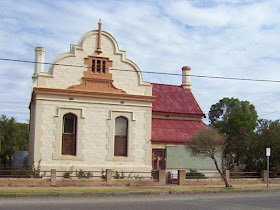 |
| The former, English Scottish and Australian bank today, on the corner of Railway Terrace and Fourth Street in Quorn |
 |
A steam train on the Pichi Richi tourist railway, Quorn, SA
|
 |
Criterion Hotel, Quorn SA, in recent times
|
 |
| Railway Terrace, Quorn, SA |
 |
| Former Bruse's Hall, was used for shops and purchased by Mr Bruse, owner of The Criterion Hotel next door, Quorn, SA |
 |
| Main Street of Quorn, South Australia |
 |
| The two storey building of residence and shop was Bewert's Bakery until the late Fifties, Quorn, SA |
 |
| Quorn, SA, Old general store was known as the Great Northern emporium and R. W. Foster's Store (1878) |
 |
| RW Foster's Great Northern Emporium, Quorn, SA |
.jpg) |
| Street of shops, Quorn, SA |
 |
| The Quorn Town Hall, 20 Railway Terrace, Quorn, was built in 1891 In the 1950’s the building was vacated as it was inadequate for the needs of the town |
 |
| Criterion Hotel, Quorn, SA, built in 1881 |
 |
| Views of Quorn, SA |
 |
| The sandstone Quorn Courthouse SA, with a corrugated galvanized iron room was completed in 1882-3 consisting of a courthouse, magistrate’s room and out offices. Electricity was first installed in the building in 1925 |
 |
| Old Quorn Motors Service Station & Shell Fuel depot, Quorn SA |
 |
| Quorn watertower, SA, with heritage advertisements |
 |
| The old Salvation Army Citadel is now an art gallery. Built 1884, Quorn, SA |
 |
| The old Bible Christian Methodist church built in 1879. Became a Lutheran Church from 1902 to 1939. Now derelict and falling down. Denisbin, Quorn, SA |
 |
| Quorn School, SA. Opened 1879. This building 1881. Another classroom was added in 1882. denisbin |
 |
| Quorn, SA. This is the headmasters residence built with the adjoining classroom in 1881. denisbin |
 |
| Old corner store now a chemist, Quorn, SA |
 |
| The Transcontinental Hotel, Quorn, SA, which was built around the same time as the Austral Hotel in the late 1870s, was one of the first stone buildings of the town. The first licence of the hotel was W.C. Greenslade util 1883. From 1900-1902, William Bruse was the hotel's licensee. In 1903, Bruse took over the Criterion Hotel and later established Bruse's Hall |
 |
| The Austral Inn, Quorn, SA, which was originally called the Pinkerton Hotel, after William Pinkerton who had camped in the Quorn area whilst droving sheep from the West Coast in 1853. It was one the first hotels built in Quorn, when this town was surveyed in 1878, as a Railway town. The first licencee was W. Armstrong from Ireland. |
 |
| Dunn’s Flour Mill (1879) on Railway Terrace, Quorn, SA, is now a hotel, was built a year after Quorn was settled. Purchased by Joseph Nicholas on 19 September 1900 and by by Henry Waters in 1906, known as Quorn Chaff-mills and Firewood Yards |
 |
Quorn Railway Station, SA, opened on 15 December 1879 as the interim terminus of the Central Australia Railway from Port Augusta
|
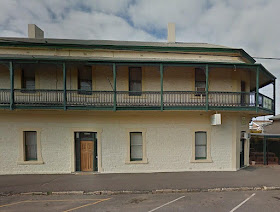 |
Today the Grand Junction Hotel, Quorn, SA, is known as the Quorn Hotel
|
Things To Do and Places To Go
Heritage Walk
Heritage Walk
The Afghan Express is a return trip to Quorn from Port Augusta (78 kilometres return)
The Pichi Richi Explorer, is a return service to Woolshed Flat departing from Quorn (32 kilometres return)
Books To Read
Songs that Sound like Blood, by Jared Thomas -The story of Roxy May Redding, who has graduated from high school and is desperate to "make it" as a musician.
Salt Creek, by Lucy Treloar - An English family try to establish a cattle farm in remote South Australia during the 1800s.














































.jpg)












































